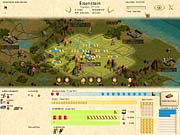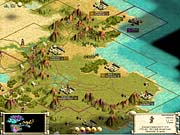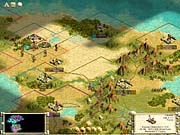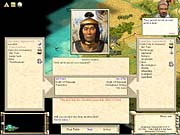Civilization III Updated Preview
We got our hands on a near complete version of Civ III. Detailed impressions inside.

Civilization is one of the best-known names in computer gaming. Its release in 1991 marked a new era in strategy game sophistication, as well as a new era of wasted time, as its hypnotizing gameplay induced countless marathon sessions by addicted gamers. The sequel was released in 1996, and Sid Meier's Alpha Centauri, released in 1999, was seen by some as the third game in the series. Along the way, the game has spawned a number of imitators in other genres and contributed heavily to the way certain concepts are treated in other strategy games. Its appearance marked a sort of era of enlightenment in strategy gaming, which would lead to the genre's rapid development. Ten years later, the true sequel to Civilization II obviously reflects Firaxis' confidence in the original design.

The many nationality choices of Civilization II have been narrowed down to look more like the choices in the original game, although you can still use the custom option to take control of any fictional nation you choose, like Vichy France. While trivial in and of itself, this culling of extraneous material is typical of the entire design. Civilization III has the feel of a game in which the designers questioned how every piece of micromanagement fit into the overall game system and excised detail in favor of gameplay cohesion. This isn't to say that Civilization III is simpler than its predecessors, but it is much more polished, both in concept and execution.
Had Civilization III turned out to be nothing more than the Civilization II engine with new graphics, a lot of people would probably have been satisfied. The visual effect of Civilization III is striking, even though the graphics aren't particularly technically advanced. Rather, they are simply evidence of good art design, with a pleasing unified feel that gives the game a definite style. Terrain types are better differentiated than in previous games, with towering mountains, rolling hills, and vast forests, all of which are more like part of the environment rather than just symbols on a map.
The graphical overhaul, while welcome, is by no means the biggest change to the game. While Civilization III follows the general model of its predecessor and incorporates several technical improvements found in Alpha Centauri, the tweaks and adjustments seem to have a strong design element of streamlining, through which several decisions have apparently been made to reduce the game's micromanagement. This is obvious from the very first time you access your city screen. All the familiar elements--shields, food, and commerce (formerly trade)--make a reappearance, and anyone who is at all familiar with the basic Civilization concept should have no problem sitting down and diving right into the game. Doing so without reading the manual would be premature, though, as several fundamental changes have been made to the game--changes that make it play differently from its predecessors.
The first thing you'll notice when sitting down with Civilization III is that your nation has two kinds of civilian units right from the outset: settlers and workers. Settlers, which now cost two population points to build, are only good for founding cities or moving populations between them. All the other tasks previously performed by settler units are now performed by workers, which cost only one population point to build and are responsible for such things as terrain improvements, pollution cleanup, and the like. Settlers and workers also no longer require food and are simply supported like normal units. They can also be captured if caught unprotected by enemy combat units. Settlers captured by the enemy become two worker units to reflect the concept of nationality, which appears elsewhere in the game as well.
Culture and Resources

The most important new design element is clearly the idea of culture. Culture affects many aspects of the game, from city radius to assimilating conquered populations, and is based on the number of cultural improvements present in your cities. Temples, libraries, cathedrals, coliseums, and similar city improvements all add to a city's culture, as do wonders of the world. In addition, the older these cultural centers are, the more valuable they become. When combined with the new cultural victory condition, this means that it's now possible to win by building an empire based on peaceful trade that funds the developments of cultural institutions, since making a lot of improvements that bestow culture points early will lead to a huge accumulation in the endgame.

Culture determines national and city boundaries. For example, at the beginning of the game, your city radius will be only one square. As soon as your first city acquires 10 culture points, its radius will extend to two squares. Thereafter, as it attains higher and higher levels of culture, its radius will continue to expand. When you move a settler unit, you're shown the effect that building a city in that particular square would have on your national boundaries. National boundaries will naturally extend to encompass other cities as long as you build them close enough together, but building far away from your previous settlements has the effect of creating an "island" that permits enemy units to encircle it without being subject to removal due to violation of your borders. This has a profound effect on the way civilizations develop in the game, as a series of unconnected cities is easier to conquer because forces can be assembled in closer proximity without the victim having any diplomatic recourse.
Because culture determines city boundaries as well as national boundaries, it also affects how resources are handled. A big change in Civilization III is that some resources on the map function almost as a combination of resources and terrain. Resources in the game are actually divided into three categories: bonus, strategic, and luxury resources. Bonus resources increase the food output of a square being worked by your population (or, in the case of gold, the commerce value) and include such things as wheat, fish, game, cattle, and whales. You take advantage of these through your city screen.
Strategic resources confer the ability to construct various units and city improvements and even to make technology advances. To build swordsmen, for example, you'll have to find a source of iron ore and connect it with roads to one of your cities. The Manhattan Project can't be built without a source of uranium. Workers can be used to build colonies that let you take advantage of resources without having them fall within your borders, and this is an important tactic due to the higher cost of establishing new cities.
Luxury resources are exploited much like strategic resources, except that instead of being prerequisites for production, they increase your population's happiness. Each type of luxury item (incense, dye, wine, fur, spice, silk, ivory, and diamonds), when connected to a city by a road, makes one content citizen happy or one unhappy citizen content. It's a powerful method for early expansion, and the fact that strategic and luxury resources are also tradable in the diplomacy screen means that rather than just being some abstract method of increasing your treasury, trade is now a legitimate strategic tool in which you must negotiate to obtain the goods you need to expand.
Combat and Diplomacy

Combat in Civilization III has been completely revamped. The concept of firepower has been eliminated and replaced with a simple system based on attack, defense, and hit points. Regular units have three hit points, veteran units have four, and elite units have five. Each combat round has a chance of inflicting a single hit-point loss on a unit, which is simply a probability based on the relative attack and defense strengths of the combatants. If a unit has an attack factor of nine and attacks a unit with a defense factor of one, it has a 90 percent chance of inflicting a hit-point loss on it during that round. Combat is accompanied by an animation of the two units fighting, which, rather than being tedious, generates a fair amount of tension as you count down your remaining hit points in the little boxing match. Zones of control have been eliminated, so movement is much more fluid. Because rivers now run between squares instead of through them, it is possible to set up a defense behind a river line.

Along with combat comes the concept of leaders. Every time an elite unit is victorious in combat, there is a small chance that it will generate a leader unit. Leaders have two functions: They can form armies, which are a sort of stacked combat unit, or they can complete the construction of a wonder or city improvement. This is much more important now that it is impossible to complete wonders by rush-building. Rounding out the changes to combat is the inclusion of civilization-specific combat units, such as the Japanese samurai and the German panzer, as well as the ability of units to perform bombardments, much like in Alpha Centauri.
When you conquer a city, it retains its previous "nationality" and will likely have units resisting your occupation. Resisting units don't contribute to production and need to be quelled with military units. Even after you subdue a city, it retains its nationality for quite a while (although it functions as your city) and can revolt because of this. After some period of time based on the strength of your nation's culture, your nation will assimilate the new city. Cities can actually switch allegiances through culture assimilation without combat, but unlike in previous games, this is based on culture and not on happiness.
Diplomacy has been greatly enhanced so that you can negotiate for specific items and even offer combinations of things--such as advances and gold or even cities and workers--to other nations in exchange for their cooperation. There are also new diplomatic agreements available. You can negotiate a right of passage for your troops with another country, so you can cross its territory without going to war and even organize a trade embargo with your allies to deny your enemies valuable resources. All in all, the diplomacy system is much more flexible and powerful than in previous games and is now a legitimate area of strategy. Related diplomatic changes include the need to pay money to establish embassies, as well as the elimination of diplomats and spies in favor of an intelligence agency improvement that enables spying activities.
Wonderful Changes

One of the things that gave the original game such a strong historical flavor was the concept of wonders of the world, which became an obligatory concept for games of this nature. Civilization III introduces the concept of small wonders. These are wonders that are not quite as impressive as the great wonders of the world and thus are not limited to one civilization. However, unlike simple city improvements, there can be only one of each in each nation. Examples of small wonders are the Forbidden Palace, which in the early game acts as a second capital in reducing corruption, and Wall Street, which lets you earn interest on your treasury balance each turn. There are 10 small wonders and 24 great wonders, with most of the recognizable names from the first two games (such as The Colossus, Magellan's Voyage, J.S. Bach's Cathedral, Hoover Dam, and the Manhattan Project, to name a few) making a reappearance.

One of the most basic changes to the game is also one of the most important: Units no longer have home cities and do not require shields for support. Unit support is now entirely dependent on income. This means that the tedious process of managing units' home cities has been eliminated. Since those elements were the basis for the way in which the city unhappiness model dealt with military units, a new concept called "war weariness" has replaced the home-city-based system. This takes into account several factors, such as having military units in enemy territory (as opposed to simply being away from their home city), the presence of enemy units in your own territory, and just engaging in battles. All of this makes going to war a much more serious event than it was in previous games in the series. The old Senate that interfered with decisions in republics and democracies has been eliminated, but the war weariness model takes government type into account and provides a similar constraint to decision-making in these societies.
There have been a number of other changes to the game, including elevation effects on fog of war, implementation of production and research queues, the elimination of bribing enemy units, and a change to the way barbarians work (they have permanent encampments and pillage your cities rather than reduce their population). Just about the only disappointing thing about Civilization III is multiplayer capability, which is not included at all. Alpha Cenaturi had play-by-email capability retrofitted in a subsequent patch, but Civilization III does not have multiplayer mode in any form--it's a strictly solo game. It follows the tradition of the first two games--also solo only--which is immensely disappointing. Civilization II was eventually rereleased in a multiplayer edition, though, and one can only hope that Infogrames and Firaxis see fit to do the same with Civilization III. In the meantime, the solo game boasts rewritten and improved AI to give veteran Civilization players a new challenge.
Civilization III is a massive game, and the way in which these design changes affect the overall game flow and balance will only become apparent after repeated playings by the many devoted fans of the series. What seems clear is that the way in which the game has been streamlined offers the potential to draw in numerous new gamers with its depth and accessibility, much in the same way that the original Civilization recruited numerous new gamers with its originality and elegance.
Got a news tip or want to contact us directly? Email news@gamespot.com
Join the conversation